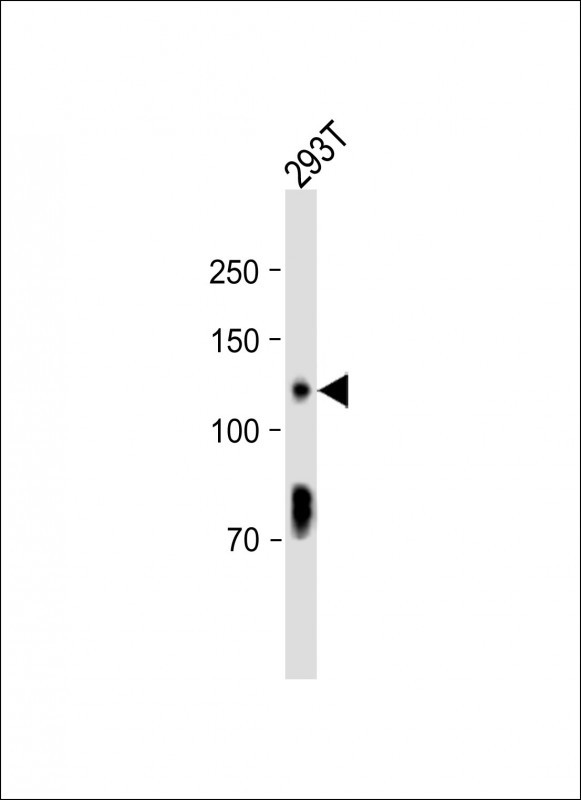UBE3C Antibody (Center)
Affinity Purified Rabbit Polyclonal Antibody (Pab)
- 产品详情
- 文献引用 : 1
- 实验流程
- 背景知识
Application
| WB, E |
|---|---|
| Primary Accession | Q15386 |
| Reactivity | Human |
| Host | Rabbit |
| Clonality | Polyclonal |
| Isotype | Rabbit IgG |
| Calculated MW | 123923 Da |
| Antigen Region | 549-578 aa |
| Gene ID | 9690 |
|---|---|
| Other Names | Ubiquitin-protein ligase E3C, 632-, HectH2, UBE3C, KIAA0010, KIAA10 |
| Target/Specificity | This UBE3C antibody is generated from rabbits immunized with a KLH conjugated synthetic peptide between 549-578 amino acids from the Central region of human UBE3C. |
| Dilution | WB~~1:1000 E~~Use at an assay dependent concentration. |
| Format | Purified polyclonal antibody supplied in PBS with 0.05% (V/V) Proclin 300. This antibody is purified through a protein A column, followed by peptide affinity purification. |
| Storage | Maintain refrigerated at 2-8°C for up to 2 weeks. For long term storage store at -20°C in small aliquots to prevent freeze-thaw cycles. |
| Precautions | UBE3C Antibody (Center) is for research use only and not for use in diagnostic or therapeutic procedures. |
| Name | UBE3C {ECO:0000303|PubMed:17323924, ECO:0000312|HGNC:HGNC:16803} |
|---|---|
| Function | E3 ubiquitin-protein ligase that specifically catalyzes 'Lys- 29'- and 'Lys-48'-linked polyubiquitin chains (PubMed:11278995, PubMed:12692129, PubMed:16341092, PubMed:16601690, PubMed:24158444, PubMed:24811749, PubMed:25752573, PubMed:25752577, PubMed:32039437, PubMed:33637724, PubMed:34239127). Accepts ubiquitin from the E2 ubiquitin-conjugating enzyme UBE2D1 in the form of a thioester and then directly transfers the ubiquitin to targeted substrates (PubMed:32039437, PubMed:9575161). Associates with the proteasome and promotes elongation of ubiquitin chains on substrates bound to the 26S proteasome (PubMed:24158444, PubMed:28396413, PubMed:31375563). Also catalyzes 'Lys-29'- and 'Lys-48'-linked ubiquitination of 26S proteasome subunit ADRM1/RPN13 in response to proteotoxic stress, impairing the ability of the proteasome to bind and degrade ubiquitin- conjugated proteins (PubMed:24811749, PubMed:31375563). Acts as a negative regulator of autophagy by mediating 'Lys-29'- and 'Lys-48'- linked ubiquitination of PIK3C3/VPS34, promoting its degradation (PubMed:33637724). Can assemble unanchored poly-ubiquitin chains in either 'Lys-29'- or 'Lys-48'-linked polyubiquitin chains; with some preference for 'Lys-48' linkages (PubMed:11278995, PubMed:16601690, PubMed:25752577). Acts as a negative regulator of type I interferon by mediating 'Lys-48'-linked ubiquitination of IRF3 and IRF7, leading to their degradation by the proteasome (PubMed:21167755). Catalyzes ubiquitination and degradation of CAND2 (PubMed:12692129). |
| Tissue Location | Highly expressed in skeletal muscle. Detected at much lower levels in kidney and pancreas. |
For Research Use Only. Not For Use In Diagnostic Procedures.

Provided below are standard protocols that you may find useful for product applications.
BACKGROUND
E3 ubiquitin-protein ligase that accepts ubiquitin from the E2 ubiquitin-conjugating enzyme UBE2D1 in the form of a thioester and then directly transfers the ubiquitin to targeted substrates. Can assemble unanchored poly-ubiquitin chains in either 'Lys-29'-or 'Lys-48'-linked polyubiquitin chains. Has preference for 'Lys-48' linkages. It can target itself for ubiquitination in vitro and may promote its own degradation in vivo.
REFERENCES
Nomura N., et al. DNA Res. 1:27-35(1994).
Hillier L.W., et al. Nature 424:157-164(2003).
Scherer S.W., et al. Science 300:767-772(2003).
Mural R.J., et al. Submitted (JUL-2005) to the EMBL/GenBank/DDBJ databases.
You J., et al. J. Biol. Chem. 276:19871-19878(2001).
终于等到您。ABCEPTA(百远生物)抗体产品。
点击下方“我要评价 ”按钮提交您的反馈信息,您的反馈和评价是我们最宝贵的财富之一,
我们将在1-3个工作日内处理您的反馈信息。
如有疑问,联系:0512-88856768 tech-china@abcepta.com.






















 癌症的基本特征包括细胞增殖、血管生成、迁移、凋亡逃避机制和细胞永生等。找到癌症发生过程中这些通路的关键标记物和对应的抗体用于检测至关重要。
癌症的基本特征包括细胞增殖、血管生成、迁移、凋亡逃避机制和细胞永生等。找到癌症发生过程中这些通路的关键标记物和对应的抗体用于检测至关重要。 为您推荐一个泛素化位点预测神器——泛素化分析工具,可以为您的蛋白的泛素化位点作出预测和评分。
为您推荐一个泛素化位点预测神器——泛素化分析工具,可以为您的蛋白的泛素化位点作出预测和评分。 细胞自噬受体图形绘图工具为你的蛋白的细胞受体结合位点作出预测和评分,识别结合到自噬通路中的蛋白是非常重要的,便于让我们理解自噬在正常生理、病理过程中的作用,如发育、细胞分化、神经退化性疾病、压力条件下、感染和癌症。
细胞自噬受体图形绘图工具为你的蛋白的细胞受体结合位点作出预测和评分,识别结合到自噬通路中的蛋白是非常重要的,便于让我们理解自噬在正常生理、病理过程中的作用,如发育、细胞分化、神经退化性疾病、压力条件下、感染和癌症。






